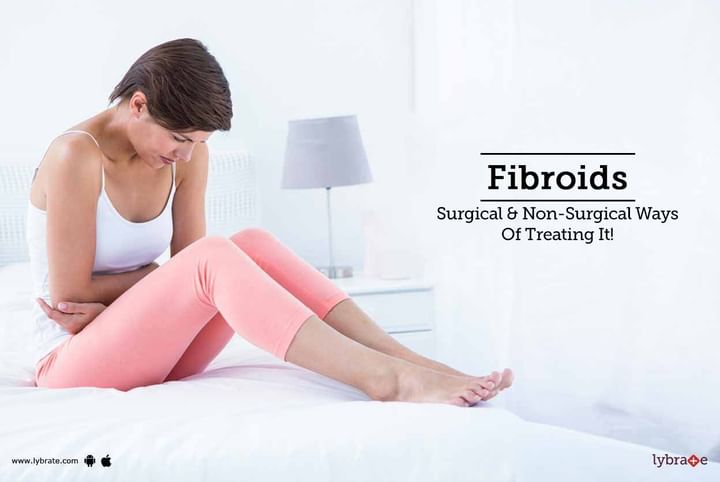Fibroids - Surgical & Non-Surgical Ways Of Treating It!
Fibroids are benign (non-cancerous) tumours of the womb (uterus). They are also known as myomas. They are growths of smooth muscle and fibrous tissue. The size of fibroids can vary from as small as a pea to that of a melon. At least one in five women develop a fibroid at some stage of their life, usually between the ages of 30-50 years old.
Fibroids are named according to where they are found in the womb. There are three types:
Intramural fibroids are found in the wall of the womb and are the most common type of fibroids found in women.
Subserosal fibroids are found growing outside the wall of the womb and can become very large. They can also grow on stalks (called pedunculated fibroids).
Submucosal fibroids are found in the muscle beneath the inner lining of the womb wall.
Symptoms
The majority of women with fibroids show no symptoms. However, if symptoms develop, they may experience one or more of the following:
-
Heavy or painful periods- in some cases this can lead to anaemia
-
Discomfort, or swelling, in the lower abdomen, particularly if the fibroids are large
-
Urinating frequently, usually if the fibroids are pressing on the bladder,
-
Constipation which can be caused by the fibroids pressing on the rectum (large intestine leading to your anus), and
-
infertility Very rarely, fibroids can cause problems during pregnancy and labour
Diagnosis
As fibroids rarely have symptoms, they are often found during a routine gynaecological (vaginal) examination. If fibroids are suspected, an ultrasound scan can be used to confirm a diagnosis. A trans-vaginal scan is sometimes used to diagnose fibroids. It involves a small scanner being inserted into the vagina to take a close-up image of the womb.
Fibroids near your inner lining, and those within the cavity of your womb, can be seen directly using a hysteroscope (small telescope used to examine the inside of your womb). To look at the size and shape of the outside of your womb a laparoscope (small flexible tubing used to look inside the abdomen) is used.
If you do not have any symptoms from your fibroids, treatment may not be necessary. Some women with minor symptoms, such as heavy periods, choose not to have treatment as their day-to-day life is not affected. After the menopause, fibroids often shrink, and your symptoms will either disappear or ease slightly.
Treatment
To treat fibroids, your GP may recommend medication. However, in more severe cases, surgery can be considered.
- Treatment with medication
- Tranexamic acid these tablets are taken from the start of your period for up to four days. The tablets work by helping the blood in your womb to clot, which reduces the amount of bleeding.
- Anti-inflammatory medicines such as ibuprofen and mefanamic acid help to ease your periods and are taken for a few days during your period. They work by reducing your body’s production of a hormone-like substance, called prostaglandin, which is linked to heavy periods. They are also painkillers but are not a form of contraceptive. Common side effects include indigestion and diarrhoea.
- The contraceptive pill is often taken, during your period, to prevent your menstrual cycle (period) from occurring. Some contraceptive pills also help to reduce any period pain you may experience.
- Levonorgestrel intrauterine system (LNG-IUS) is a small plastic device that is placed in your womb and slowly releases the progestogen hormone called levonorgestrel. It prevents the lining of your womb from growing quickly so your bleeding becomes lighter. Possible side effects of LNG-IUS include; having irregular bleeding that may last for more than six months, acne (inflamed skin on the face), headaches, and breast tenderness. The most effective medication to treat fibroids is an injected hormone medicine called
- Gonadotropin releasing hormone agonist (GnRHa). GnRHa works by preventing your menstrual cycle (period), but it is not a form of contraceptive. However, it does not affect your chances of becoming pregnant after you stop using it. Common side effects include menopause-like symptoms, such as hot flushes, increased sweating, and vaginal dryness. Osteoporosis (thinning of the bones) is a less common side effect.
- Surgical procedures Surgical procedures, for treating fibroids, are usually considered for large fibroids (>5cm) or if medications are ineffective in relieving symptoms. Common surgical procedures that are used to treat fibroids include:
- Myomectomy involves surgery to remove the fibroids from the wall of your womb. A myomectomy is an alternative to having a hysterectomy, particularly for women still wishing to have children. However, the procedure may not always be possible as it depends on your individual circumstances, such as the size, number and position of your fibroids.
- Hysterectomy involves surgery to remove the womb. A hysterectomy is not usually necessary unless the fibroids are very large or you have severe bleeding. A hysterectomy may be advised in order to prevent fibroids recurring.
- Endometrial ablation is removal of the womb lining. It is usually only carried out if your fibroids are near the inner surface of your womb. The affected womb lining is removed, which may be done in a number of ways, including using laser energy, a heated wire loop, microwave heating, or hot fluid in a balloon.
In case you have a concern or query you can always consult an expert & get answers to your questions!



+1.svg)
